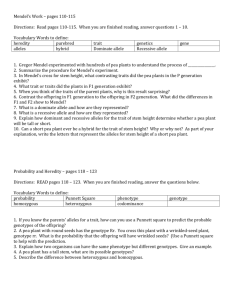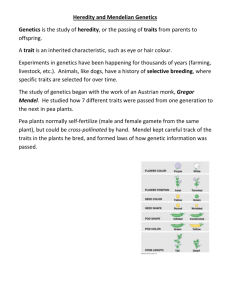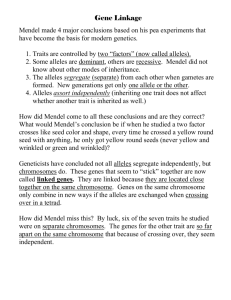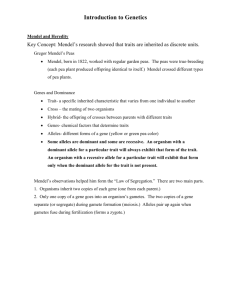Unit 2 - Chapter 5.1 Mendel0
advertisement
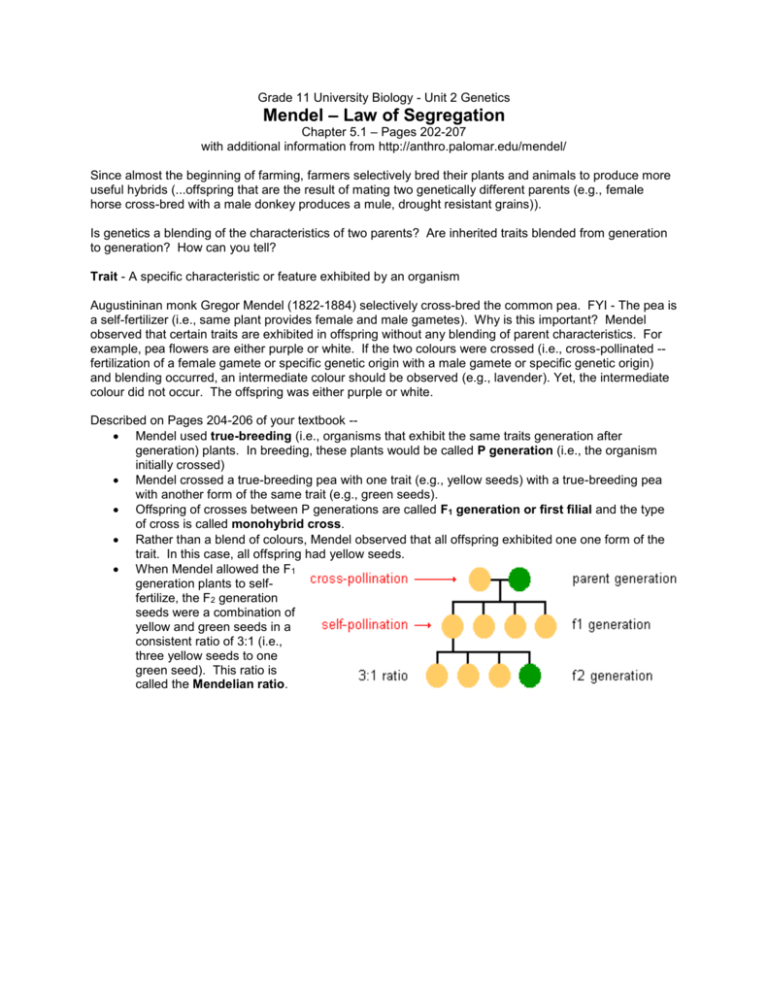
Grade 11 University Biology - Unit 2 Genetics Mendel – Law of Segregation Chapter 5.1 – Pages 202-207 with additional information from http://anthro.palomar.edu/mendel/ Since almost the beginning of farming, farmers selectively bred their plants and animals to produce more useful hybrids (...offspring that are the result of mating two genetically different parents (e.g., female horse cross-bred with a male donkey produces a mule, drought resistant grains)). Is genetics a blending of the characteristics of two parents? Are inherited traits blended from generation to generation? How can you tell? Trait - A specific characteristic or feature exhibited by an organism Augustininan monk Gregor Mendel (1822-1884) selectively cross-bred the common pea. FYI - The pea is a self-fertilizer (i.e., same plant provides female and male gametes). Why is this important? Mendel observed that certain traits are exhibited in offspring without any blending of parent characteristics. For example, pea flowers are either purple or white. If the two colours were crossed (i.e., cross-pollinated -fertilization of a female gamete or specific genetic origin with a male gamete or specific genetic origin) and blending occurred, an intermediate colour should be observed (e.g., lavender). Yet, the intermediate colour did not occur. The offspring was either purple or white. Described on Pages 204-206 of your textbook - Mendel used true-breeding (i.e., organisms that exhibit the same traits generation after generation) plants. In breeding, these plants would be called P generation (i.e., the organism initially crossed) Mendel crossed a true-breeding pea with one trait (e.g., yellow seeds) with a true-breeding pea with another form of the same trait (e.g., green seeds). Offspring of crosses between P generations are called F1 generation or first filial and the type of cross is called monohybrid cross. Rather than a blend of colours, Mendel observed that all offspring exhibited one one form of the trait. In this case, all offspring had yellow seeds. When Mendel allowed the F1 generation plants to selffertilize, the F2 generation seeds were a combination of yellow and green seeds in a consistent ratio of 3:1 (i.e., three yellow seeds to one green seed). This ratio is called the Mendelian ratio. Mendel concluded that the green seed trait had not disappeared in the F 1 generation. Rather, the trait was not exhibited. Moreover, Mendel observed that the 3.1 ratio occurred in future generations. Mendel presented three key ideas. 1. Inheritance of each trait is determined by "factors" that are passed on unchanged to descendents (...now called alleles) 2. An individual inherits one factor of each trait from each parent 3. A trait may not show up in an individual but it can still be passed to the next generation Using the example, each pea plant had two alleles for seed colour. Although all the F 1 generation seeds were yellow, each seed had each gene for seed colour (i.e., both green and yellow). In this case, yellow is the dominant form (i.e., form a trait that always appears when an individual has an allele for it) and green is the recessive form (i.e., the form of a trait that only appears when an individual has two alleles for it) Mendel proposed the Law of Segregation. In it, traits are determined by pairs of alleles that segregate during meiosis so that each gamete receives one allele. The offspring inherits one allele from each parent. The exhibited trait depends on the inheritance of dominant or recessive alleles. If the dominant allele is present, that trait is always exhibited. To exhibit the recessive trait, two recessive alleles (...one from each parent...) must be inherited. Today, alleles are represented by upper- and lower-case letters. Dominant is upper-case while recessive is lower-case (e.g., Yy) Since each diploid organism has two alleles for each generation, there must be three allele combination (e.g., YY, Yy and yy). The combination of alleles for any given trait or the organism's entire genetic make-up is called the genotype. The exhibit of the genotype is the phenotype. An individual with two identical alleles is homozygous (e.g., YY (homozygous dominant), yy (homozygous recessive)), while an individual with two different alleles of a gene is heterozygous (e.g., Yy). HOMEWORK QUESTIONS Page 207, Questions 1-12

